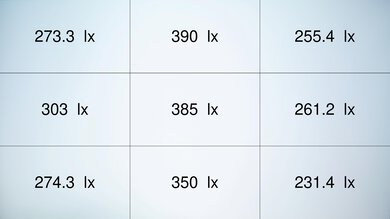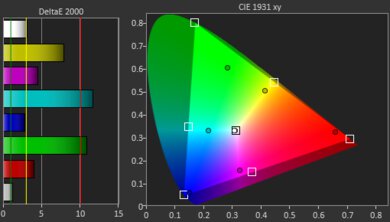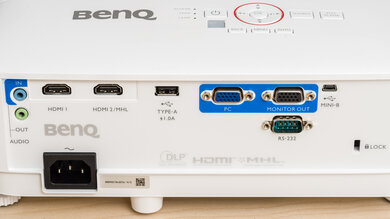The BenQ TH671ST is a 1080p short-throw projector primarily aimed at home theater use, although it doesn't support HDR. It projects a 100" image at a distance of 5 to 6 feet, 120" at a distance of 6 to 7.2 feet, and up to 180" at a distance of ~9 feet. The projector has no automatic geometry correction features, but it has a manual 2D vertical keystone adjustment of up to 40 degrees to eliminate trapezoid effects. It has two HDMI 1.4 ports, each capable of up to 1920 x 1200 or 1080p @ 60Hz, with one integrated 5W speaker.
Our Verdict
The BenQ TH671ST is decent for watching movies. Its brightness is mediocre, but its contrast is satisfactory, so watching movies in pitch-black rooms is a pleasant experience. The projector's color gamut is very good, but it isn't bright enough to make colors pop, and this model doesn't have HDR support. The projector's color accuracy before calibration is great; it's easily good enough for all but the most ardent color purists.
-
Satisfactory contrast for a pleasant movie watching experience in dark rooms.
-
Great image accuracy prior to calibration.
-
Wide color gamut in SDR.
-
Doesn't support HDR.
-
Only mediocre brightness, so it doesn't perform very well in rooms with lights.
- 7.1 Movies
Changelog
- Updated Sep 13, 2024: We mentioned the newly-reviewed BenQ X500i in the Smart Features & Sound section of this review.
- Updated Aug 05, 2024: Updated text throughout the review according to Test Bench 0.9, mainly in the Verdict, Compared To Other Projectors and Contrast sections.
- Updated Aug 02, 2024: We've converted this review to Test Bench 0.9. We've overhauled our Contrast tests, as we now measure contrast at various average pixel levels (APL). You can see the full changelog here.
- Updated Feb 23, 2024: Review published.
- Updated Feb 21, 2024: Early access published.
Check Price
Differences Between Sizes And Variants
We bought and tested the BenQ TH671ST. It's an older product and has since been replaced in BenQ's Home Theater projector lineup by other models, like the BenQ HT2050A, BenQ HT2060, and the BenQ HT2150ST.
Compared To Other Projectors
The BenQ TH671ST projector is a decent 1080p projector for watching movies in a dark room due to its satisfactory contrast. It performs better in dark rooms than other comparable models, like the Epson Home Cinema 1080 or the Epson EpiqVision Flex CO-W01, although they're both far better than the BenQ in brighter rooms due to their higher peak brightness. Ultimately, this makes the BenQ a great value if you're shopping for a cheaper projector for use in darker rooms, and it's more versatile than its contemporaries when it comes to room placement due to its short-throw capabilities.
Check out our recommendations for the best short-throw projectors and the best projectors for home theater. If you'd prefer a cheaper unit, look up the best cheap projectors instead.
The BenQ HT2060 is better than the BenQ TH671ST. While the TH671ST is easier to carry around due to its smaller size and lighter weight, it doesn't have any adjustable feet, nor does it have any auto keystone correction, both of which the HT2060 has. When it comes to image quality, the TH671ST does have a wider color gamut, but it doesn't support HDR. The HT2060 has HDR, is slightly brighter, and has noticeably better contrast, making it the better and more modern product of the two. If you're looking to install your projector closer to the wall, the TH671ST is a short-throw projector, so it can project at a shorter range than the HT2060 can.
The Epson Home Cinema 1080 and BenQ TH671ST excel in different room contexts. The Epson is significantly brighter and looks better in rooms with lights, while the BenQ has better contrast, so it performs better in dark rooms. The Epson has Wi-Fi and integrated casting support, making it easier to use out of the box than the barebones BenQ. Overall, if you're mostly watching movies in dark rooms then the BenQ is a bit better, otherwise the Epson is brighter and easier to place in a variety of rooms.
The BenQ HT2050A offers better image quality than the older BenQ TH671ST. Unfortunately, this comes at a cost, as the HT2050A has inadequate color accuracy out of the box, while the TH671ST excels in that area. If you're willing to calibrate it, then the HT2050A projects a brighter image, with better contrast, than the TH671ST.
The Epson EX3280 and BenQ HT2050A are different projectors, each with strengths and weaknesses. The EX3280 is the brighter projector, as it is bright enough even for well-lit rooms. Inversely, the BenQ TH671ST has better contrast, so it looks its best when the lights are off. Ultimately, the BenQ is the better product for content consumption as it projects a 1080p image with a 16:9 aspect ratio, while the Epson's 1024 x 768 4:3 resolution is not well suited for watching movies and is better used as an office machine.
The Epson EpiqVision Flex CO-W01 and BenQ TH671ST excel in different areas, although the BenQ is a bit better overall. The Epson is the far brighter projector as it's meant for use in bright offices with lots of light. Conversely, the BenQ has far superior contrast, making it the better choice to watch movies in a dark room. The BenQ is also a bit more colorful due to its wider color gamut, and it's much more accurate out of the box than the Epson.
The BenQ X500i is much more expensive than the BenQ TH671ST, but it also outperforms it in every way. They're short-throw projectors with an identical throw ratio, meaning that they can both be placed at the same distance from the wall or screen. Still, the X500i is a bit brighter, has better contrast, and is more accurate out-of-the-box. The X500i also has more features for gamers and comes with the advanced QS02 dongle, giving it a well-rounded set of streaming/wireless features. In comparison, the TH671ST doesn't come with a dongle and doesn't have any wireless features or a smart OS as a result.
Test Results
The BenQ TH671ST projector isn't meant to be portable as it doesn't have any automatic geometry correction features, and you need to plug it in as it doesn't have an integrated battery. As it's only 5.9 pounds, it's still pretty easy to carry around. It doesn't have an adjustable stand, but it does have slightly adjustable feet. It has one 5W speaker, so you don't absolutely need to connect it to a soundbar or sound system.
This DLP projector uses a lamp as its light source, which can last from 4000 to about 15000 hours, according to the manufacturer, after which you'll need to swap the lamp for a new one. As it's a 1080p projector, it's limited to outputting a 1080p @ 60Hz resolution and doesn't have HDR support. It's a short throw projector, so you can place it close to the screen as it projects a 60" image at a distance of ~3 feet up to a 180" image at a distance of ~9 feet. Its 1.2x optical zoom lets you adjust the projection size without physically moving the unit.
This projector has mediocre brightness. The sides of the projection are noticeably dimmer than the center, and it's just not very bright overall, although it's bright enough for a dim room. The BenQ HT2050A is much brighter, in case you want to keep a few lights on.
The BenQ TH671ST has satisfactory native contrast, leading to a pleasant viewing experience in dark rooms. The brighter BenQ HT2050A has even better contrast, making it more versatile than the TH671ST.
This projector has great color accuracy out-of-the-box. There are some very minor accuracy errors in the unit's colors and white balance, and its color temperature leans a bit too cold. Still, overall, it's accurate enough for all but the most ardent color purists.
This projector has 2-point white balance calibration and full-color calibration. After calibration, the projector's color accuracy is excellent. The white balance is stellar, and the color temperature is almost spot-on.
Users who prefer a brighter but less accurate image can enable the 'Brilliant Color' setting. We measured about 106 nits with the setting turned off and ~190 nits with it on. Here are the measurements with the setting on:
The BenQ TH671ST doesn't have a smart OS, but it does have one 5W speaker. If you'd prefer a projector with lots of smart features right out of the box, the BenQ X500i comes with BenQ's QS02 streaming dongle, giving it a smart OS alongside many wireless features.
This projector has two HDMI 1.4 ports, each capable of up to 1920x1200 or 1080p @ 60Hz. The HDMI 2 port has HDCP 1.4 support, so you can watch HDCP-encrypted content, like movies from streaming apps or physical media, through that port. The HDMI 2 port also has MHL support, so you can plug your phone or tablet directly into your projector to project it on the screen. There are two USB ports, but unfortunately, the mini USB port is a service port, and the bigger USB Type-A port is for power delivery only. The projector doesn't support Bluetooth or Wi-Fi.
Comments
BenQ TH671ST: Main Discussion
Let us know why you want us to review the product here, or encourage others to vote for this product.
Update: We uploaded the latest brightness measurements and uniformity photos for the Accelerated Longevity Test.
























